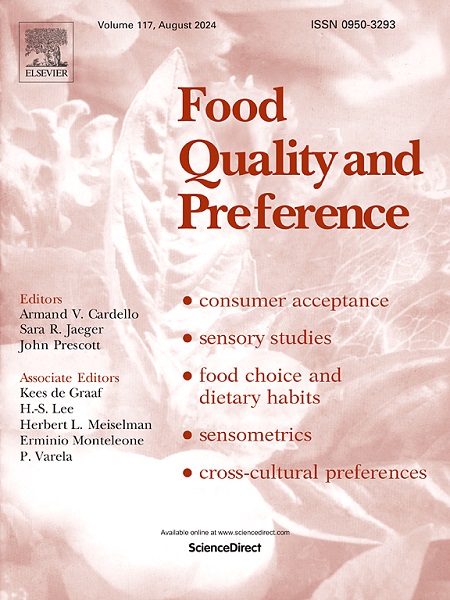A large-scale investigation of eating behaviors and meal perceptions in Italian primary school cafeterias: The relationship between emotions, meal perception, and food waste
IF 4.9
1区 农林科学
Q1 FOOD SCIENCE & TECHNOLOGY
引用次数: 0
Abstract
We explored the relationships between meal perception, emotions, and food waste in different age groups in primary school cafeterias. The aims were to assess the effect of age and gender on perceptions of the cafeteria’s meals, emotions, and food waste, and to assess the relationships among food waste, meal perception, and emotions. 1,092 children (5–11 years old [y.o.], 53 % females) completed a questionnaire in nine Italian schools. The main collected variables were the pleasure of eating in the cafeteria, declared liking for different foods, emotional responses to eating in the cafeteria, meal description evaluated as binary choices considering different aspects (duration, presence of noise, perceived comfort, crowding, fun, possibility of movement), and food waste (overall and for different foods). Age but not gender significantly affected meal perception, emotions, and food waste. The general attitude towards eating in the cafeteria was more positive among the youngest children (6–7 y.o.), while it steadily worsened from 8 y.o. on. Pasta, meat, and fruits were consistently the most liked foods, fish, vegetables, and legumes the least. Mealtime in the cafeteria was generally described as noisy and crowded, but also comfortable and fun. Children used negative emojis less to describe the mealtime. Food waste was high: 22 % of children declared leaving food on the plate “frequently” and 8 % “always.” However, lower food waste was associated with a positive emotional status and a positive meal perception. Intervention actions should improve the emotional response and the lunch environmental context in school cafeterias.
意大利小学食堂就餐行为和就餐感知的大规模调查:情绪、膳食认知和食物浪费之间的关系
我们探讨了小学食堂中不同年龄组的膳食感知、情绪和食物浪费之间的关系。目的是评估年龄和性别对食堂膳食、情绪和食物浪费感知的影响,并评估食物浪费、膳食感知和情绪之间的关系。意大利九所学校的 1092 名儿童(5-11 岁,53% 为女性)填写了调查问卷。收集到的主要变量包括:在食堂用餐的愉悦感、对不同食物的喜爱程度、在食堂用餐时的情绪反应、用餐描述(考虑到不同方面(用餐时间、是否有噪音、感觉是否舒适、拥挤程度、趣味性、活动的可能性)的二元选择)以及食物浪费(总体情况和不同食物的浪费情况)。年龄(而非性别)对用餐感知、情绪和食物浪费的影响很大。年龄最小的儿童(6-7 岁)对在食堂就餐的总体态度较为积极,而从 8 岁开始,这种态度逐渐变差。面食、肉类和水果一直是最受欢迎的食物,鱼类、蔬菜和豆类则是最不受欢迎的食物。人们普遍认为在食堂用餐既嘈杂拥挤,又舒适有趣。孩子们较少使用负面的表情符号来描述用餐时间。食物浪费现象严重:22% 的儿童表示 "经常 "和 8% 表示 "总是 "把食物留在盘子里。然而,较少的食物浪费与积极的情绪状态和积极的用餐感知有关。干预行动应改善学校食堂的情绪反应和午餐环境。
本文章由计算机程序翻译,如有差异,请以英文原文为准。
求助全文
约1分钟内获得全文
求助全文
来源期刊

Food Quality and Preference
工程技术-食品科技
CiteScore
10.40
自引率
15.10%
发文量
263
审稿时长
38 days
期刊介绍:
Food Quality and Preference is a journal devoted to sensory, consumer and behavioural research in food and non-food products. It publishes original research, critical reviews, and short communications in sensory and consumer science, and sensometrics. In addition, the journal publishes special invited issues on important timely topics and from relevant conferences. These are aimed at bridging the gap between research and application, bringing together authors and readers in consumer and market research, sensory science, sensometrics and sensory evaluation, nutrition and food choice, as well as food research, product development and sensory quality assurance. Submissions to Food Quality and Preference are limited to papers that include some form of human measurement; papers that are limited to physical/chemical measures or the routine application of sensory, consumer or econometric analysis will not be considered unless they specifically make a novel scientific contribution in line with the journal''s coverage as outlined below.
 求助内容:
求助内容: 应助结果提醒方式:
应助结果提醒方式:


